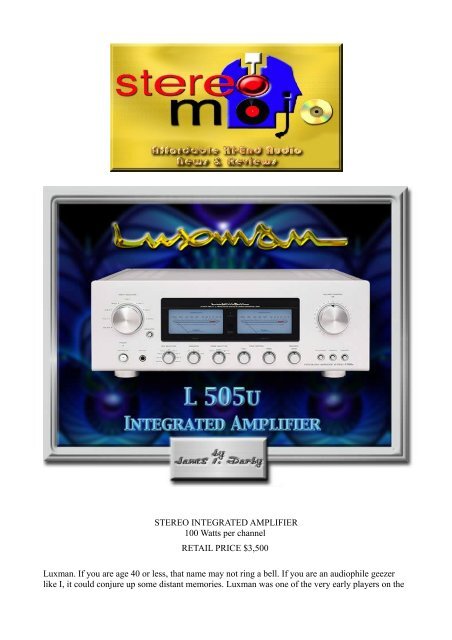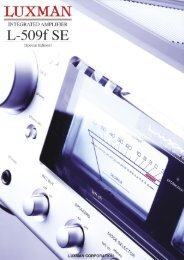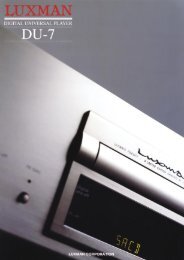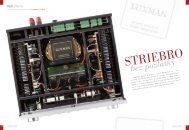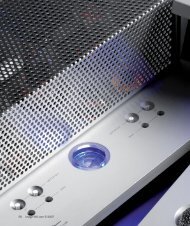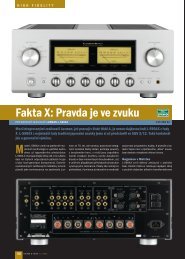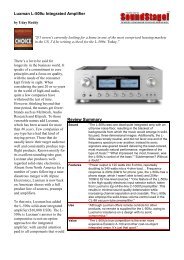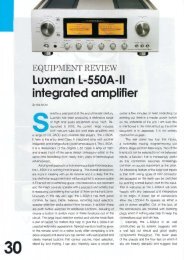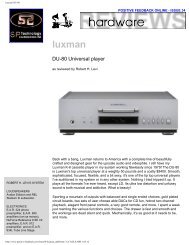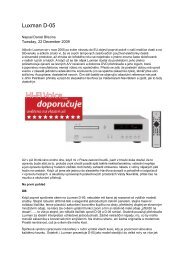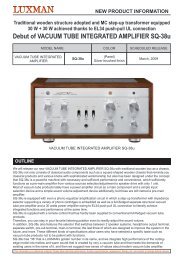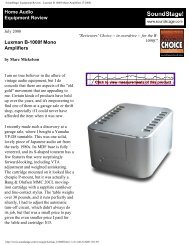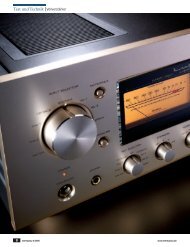LUXMAN L-505u - test (EN)
LUXMAN L-505u - test (EN)
LUXMAN L-505u - test (EN)
Create successful ePaper yourself
Turn your PDF publications into a flip-book with our unique Google optimized e-Paper software.
STEREO INTEGRATED AMPLIFIER<br />
100 Watts per channel<br />
RETAIL PRICE $3,500<br />
Luxman. If you are age 40 or less, that name may not ring a bell. If you are an audiophile geezer<br />
like I, it could conjure up some distant memories. Luxman was one of the very early players on the
audio scene in Japan, being born circa 1925. They were also big in the US in the 70’s and 80’s,<br />
ranking up there with McIntosh in the ultra luxury pantheon. Luxman was known for their<br />
impeccable build quality in those brushed gold cases and smooth sound. You would find them<br />
mostly in “old money” households or new moneyed people who wanted everyone to think they<br />
were old money. Doctors, lawyers and entertainers bought the tube driven products in very select,<br />
elite audio boutiques.<br />
The ranks of Luxman designers were populated by men like Atsushi Miura and Masami Ishiguro<br />
who went on produce the Airtight audio brand and Taku Hyodo who formed Leben. Oh, and there<br />
was also some wanker named Tim de Paravicini who designed many of Luxman’s best efforts. Tim,<br />
a real Italian Baron for those who don’t know that name, started EAR and still designs some of the<br />
best tube gear in the universe.<br />
That all changed in 1985 when the son of the founder sold out to slightly better than run-of-the-mill<br />
car audio maker, Alpine. It turned out to be wise on their parts because Alpine took the uber solid<br />
brand name and, in an effort to compete with Yamaha, started making really crappy mid-fi trash and<br />
sold them in bastions of the high end like Costco. Costco! Can you imagine dropping into Costco to<br />
pick up 24 rolls of UltraCharmin and seeing McIntosh amplifiers sitting next to the $39 DVD<br />
players? I might not fall on a ninja sword, but there would soon be a “cleanup on aisle 17”…<br />
Fortunately, Alps was never foolish enough to rebrand actual Luxman product which was still made<br />
and sold in Japan.<br />
Ten years later, Luxman was sold to Samsung. I’m told that when that deal went through, all of<br />
Luxman’s English speaking export people committed employment hari kari and resigned en masse,<br />
taking with them the capability to export to the US and other countries.<br />
Both the Alps and Samsung fiascos failed and in 2000 the brand was sold back to Luxman who had<br />
continued to successfully sell their original, untarnished products in Japan. Apparently there were<br />
no Costcos on the mainland then. In 2007, Philip O’Hanlan, best known for putting Halcro at the<br />
top of the high-end map, agreed to take on the task of reincarnating Luxman in the States through<br />
his “On a Higher Note” distributorship. We thank Philip for trusting Stereomojo enough to send us<br />
the first <strong>505u</strong> for review. We also thank Mr. O’Hanlon for doing a great job in getting the texts<br />
translated from English to Japanese and back again for an email interview with Luxman voicing<br />
guru Mr. Hashimoto at the end of our listening <strong>test</strong>s.<br />
GODZILLA STRIKES AGAIN
Like the giant dinosaur who terrorized Japan in the movies, the first thing you notice about the<br />
L-<strong>505u</strong> is its size and weight. At 18.3” wide, 7”<br />
high and a whopping 17.25” deep, its big.<br />
Weighing in at over 46 pounds, its heavy, too.<br />
Adding to that, it comes equipped with more<br />
features than a 24-screen Cineplex. From left to<br />
right on the selector, you start with a balanced<br />
input for your high-end CD player. Then there are<br />
four standard inputs plus two tape monitors. Last<br />
but certainly not least is an input for your<br />
turntable that can be toggled for either MM or<br />
MC - a very rare feature for an integrated at any<br />
price. YEAH, baby! Input sensitivity is<br />
2.5mV/47KΩ for moving magnets and<br />
0.3mV/100Ω for you moving coil fans.<br />
There is also a headphone jack for us headfi junkies. The amp can be put into standby with the push<br />
of a button as well.<br />
The goodies don’t stop there. You can record from any of the eight inputs via the left knob, select<br />
between 2 pairs of speakers or both, and yes, there’s even a mode selector if you want to listen to<br />
either channel or mono. Tone controls? Yep. You got your bass and treble right there, sport, with a<br />
bypass switch to remove them from the circuit if you don’t need to raise or lower the tone controls<br />
by up to 10db. (Incidentally, all listening <strong>test</strong>s were done with the tone controls in bypass mode). I<br />
listened to dozens and dozens of recordings and never felt the need to engage the, but you might.<br />
Distributor O'Hanlon says he uses them on some contemporary recordings such as Alicia Keyes and<br />
Gwen Stephanie (Gwen Stephanie?) as well as classical CD's such as Bernstein's 1960's Mahler<br />
cycle which he finds too bright and unlisteneable. He's right there, that's why I don't often listen to<br />
them. Even some of DG's new releases still glare like Xenon headlights at night in the rain. "Engage<br />
the tone controls, turn the treble control back to 11:00 o'clock and Voila! What was unlistenable can<br />
now be enjoyed without continually squirming in your chair", he instructs. Fair enough.<br />
There is a balance control, too. And we can’t leave out the subsonic filter for woofer relief when<br />
playing your vinyl or the traditionally mismarked “loudness” button that boosts bass a bit to<br />
compensate for the Fletcher/Munson curve which tells us that our perception of bass goes down<br />
when we lower the volume. This button is for quiet listening, not to goose the low end when<br />
listening to hip hop, ok?
One feature that even the obnoxiously festooned<br />
Kenwood did not include is hidden around back on<br />
the 505. When pushed, a small button (right) lights up<br />
to indicate if the power coming to the amp is not the<br />
correct phase – indicating some careless electrician<br />
wired the hot & neutral in your house in reverse. It<br />
happens more than you would believe, and it does<br />
affect sound quality. Pretty cool, eh?<br />
So far, we have only covered what’s on the front<br />
panel. The well written owner’s manual takes<br />
seven pages just to briefly describe all the<br />
features. Whew. The only amp I’ve seen with<br />
more features was a Kenwood receiver a buddy<br />
brought back from Asia on his return from Viet<br />
Nam in the '70's. This thing had an electronic<br />
drum machine built in, two mic inputs and an<br />
adjustable spring reverb for Karaoke among<br />
several other bells and whistles. I was forced to<br />
buy it from him as part of a package deal for his<br />
Revox A77 reel-to-reel. Naturally, the Kenwood<br />
sounded as dorky as it looked, which as we will<br />
see, is definitely not the case with this beast.<br />
The back panel has jumpers that allow you to use it as a pre-amp or a power amp, or insert some<br />
device in the path – like a reverb unit or drum machine for Karaoke. Seriously, by taking the front<br />
L+R output from a HT processor and connecting to the Main Amp IN, when you hit the "separate"<br />
switch on front panel, you can alternate control of the Luxman's amplifier from the built in preamp<br />
to the external HT processor. Use the 505 natively for music and "separate" for round sound.<br />
When I asked Hashimoto-san why so many features were included, he said that over the years, users<br />
have requested them. “We want a lot of people to use our products, so that is why we include them.”<br />
Capitalism is alive and well in Japan!<br />
A full function remote is included that lets you turn the unit on and off, adjust or mute the volume<br />
and switch directly to any of the inputs.. It fits well in the hand, its layout is ergonomically planned
and is not too big as to be a paper weight nor so small it can easily be lost in a chair cushion. While<br />
not backlit, it really does not need to be. It is made from plastic and<br />
seems a little like it should be made of metal in keeping with the<br />
big Lux’s substantial look and feel. Such are found in their more<br />
costlier models. When I think about it though, it is probably a wise<br />
decision to do a little cost cutting here rather than in something that<br />
would compromise the sound quality. The volume control via<br />
remote is very well calibrated, unlike some that force you to<br />
struggle to find just the right level for playback. There is no LED<br />
built into the volume knob on the amp that tells you the volume<br />
setting at a glance . You have to go to the next model up to get that.<br />
Again, not something that affects sound quality.<br />
I’ve<br />
saved<br />
my<br />
favorite feature for last. Not too big and<br />
not too small, easily read from across<br />
the room are the two ultra-cool, light<br />
blue power meters that grace the stylish<br />
front panel. They will tell you at a glance how much of the amp’s 100 watts per channel are being<br />
used. The meters are calibrated from -60dB below full rated power to +3dB above rated power. Like<br />
gazing at the flames in a cozy fireplace or watching the aqua waves drift in on a sandy, isolated<br />
beach, there is just something mesmerizing about contemplating power meters dancing with the<br />
music. Call them a computer visualization in its simplest form. Whatever you call it, meters are a<br />
dying trend, often not even found on very expensive mono block power amps. Adding even more to<br />
the enjoyment is the fact that the meter’s backlight can be easily switched off via the remote for<br />
those times when total darkness is desired.
Speaking of care being taken in layout and design, one glance at a topless Luxman will speak<br />
volumes about the fastidiousness of the designers. It is amazing that so many features can be<br />
implemented in a design and still have the soul of the amp look this pristine and minimalist. The<br />
power transformer, electrolytic capacitors and amplifier output stage are laid out so as not to<br />
eletronically interfere with each other. To reduce interference further, the block construction isolates<br />
each section using shielding panels and extensive internal filtering to reject magnetic flux<br />
interference. The substantial cooling fins as well as the many slots in the upper casing help keep<br />
temperatures low, extending the life and reliability of the product.<br />
Here’s an audio trivia question for you: Who holds the patent on Global Negative Feedback in<br />
amplifier circuits? Gasp! Why it’s Luxman! But…what amplifier company does not use Global<br />
Negative Feedback in their amp designs? Surprise! It’s also Luxman. Instead, they have developed a<br />
distortion reduction circuit called “Only Distortion Negative Feedback”(ODNF). This system works<br />
by isolating noise and distortion at the output from the music signal and sparingly applying negative<br />
feedback to suppress them. Conventional negative feedback systems can have an adverse effect on<br />
the music, introducing phase distortion. The circuit features such an ultra-wide range, ultra- high<br />
slew rate and ultra low distortion that it does not use phase compensation for the music signal<br />
amplifying circuits. They say this new technology also ensures the need for a DC servo circuit is<br />
alleviated, again improving sound quality.<br />
This is probably a good time to note that the L-505 is not a new model. Hardly. It’s been around for
over thirty years. But as Buddha might have said, “Things that are the same can be very different”.<br />
Luxman has never ceased developing and improving the 505 which is normally their top seller. As<br />
new and better technology comes along, they incorporate it; often trickling down from their most<br />
expensive models. The “U” letter in the model name designates the 505’s long upgrade path. In<br />
addition, I think it is also germane to point out that very early on in the 1920’s as a way to control<br />
quality, Luxman decided to start designing and producing their own parts in house. As you probably<br />
know, most amps are an amalgam of parts made by other parties, thus amp makers are at the mercy<br />
of the parts makers and their design decisions. Keeping things in house assures that Luxman is in<br />
control - another indication of Luxman’s pursuit of and insistence on ultra-high quality. For<br />
example, as Mr. O'Hanlon pointed out, they even <strong>test</strong> the color of the paint they use on their<br />
resistors. It seems some colors, because of the pigment characteristics, sound better than others.<br />
"Even the chassis fastening settings are not left to chance, but are determined after numerous hours<br />
of listening. Too tight a box hardens the sound", he added.<br />
THE INTERVIEW<br />
As always, the first question posed was, what was your overall design goal for the L-<strong>505u</strong>?<br />
“We design to heighten the listener’s musical awareness; both insight and emotion. Luxman's<br />
products allow music's power of expression to convey emotion. L-<strong>505u</strong> is the entry model for our<br />
integrated amplifiers; it has all the base performance and is also voiced like the other (more<br />
expensive Luxman) integrated amplifiers. Our ultimate goal is to relax the listener into a state of<br />
comfort so that he/she can listen more and more and bask in the afterglow of the music. The L-<strong>505u</strong><br />
is based on the 80Th Anniversary Commemoration models - C-1000f and B-1000f. It includes<br />
elegance, conveys a comfortable music style and projects a tangible soundstage”.<br />
O'Hanlon expanded on this point, using as a specific example the Source Selector pictured earlier.<br />
It's a tricke down from the $30,000 C-1000f preamp Hashimoto mentioned.<br />
Every designer has told me it is much more difficult to design an entry level product than a "cost no<br />
object" piece. Compromises must be made. How they deal with the compromises gives insight to<br />
their view on quality vs. price.<br />
“The compromise for this model is spacious feeling. Even using down graded quality parts for<br />
L-<strong>505u</strong> (down graded in comparison to the components used in the other more expensive models),<br />
we tried not to lose the "spacious feeing". This is the crucial point in product tuning. Even though<br />
the way tonal quality and resonances are heard are tuned to a very high standard, the 505 would<br />
not provide the grandness (soundstage) and the sense of effortless realty as the high end product<br />
would do.”<br />
I also asked Hashimoto to describe the sonic characteristics he was trying to achieve;<br />
“What we are trying to achieve is to generate alpha wave in the listener’s brain, so that they can<br />
feel (visualize?) the expression of players, the size of music hall similar to a live performance. As<br />
their drink gets tastier and they would want to listen (to the music) longer. These are the sonic<br />
characteristics that we are aiming for. Alcohol, Sake, wine, and beer become more delicious. Music<br />
makes people feel that they want to be listening forever. I want to make comfortable sound”.<br />
Without being too presumptuous, I think what Hashimoto-san was saying here with "comfortable<br />
sound" is that he unknowingly agrees with my definition of high-end sound. High end sound is that<br />
which does not require the listener to work or strain in the least to hear all the elements of a
ecorded musical performance. Does that make sense? With a proper system, you automagically<br />
find that you are not actively listening to the music, you are immersed in it. Music is something that<br />
happens to you, not something to which you need to adjust your senses. I don't know about you, but<br />
I am much more "comfortable" when I don't have to work to listen more closely for detail, rhythm,<br />
timbre and all the other qualities we strive to describe. A good system, at whatever price, forces you<br />
to forget that you are listening to a "system" at all. There is no impediment between you and the<br />
performance. There is a threshold that is crossed when this happens. The problem is, that threshold<br />
is different for different people. Like pain, some people have a high threshold, others quite low. And<br />
that, my friends, is what makes the high-end go 'round.<br />
LUXILLA LEAVES TOKYO TO TAKE ON THE WORLD<br />
As I listened to dozens of recordings in every format, one word kept spring to mind: Balance.<br />
Sonically, from top to bottom the L-<strong>505u</strong> exhibited strength and quality with no readily identifiable<br />
weak links. At $3,500, as its designer already noted, it does not soar to the level of pricier products,<br />
but its high level of consistency throughout is remarkable - a tribute perhaps to the three decades of<br />
refinement. “Refined” is another apt adjective. Smooth as Japanese silk in all aspects of operation<br />
as well as audio performance. Nothing jumps out at you as either a “Wow! Listen to that!” or “Huh<br />
oh…listen to that”.<br />
Take for example the soundstage. It is big but not “huuuuge” as it extends well beyond the speakers<br />
in all directions. Some might consider anything much more expansive as being exaggerated.<br />
Nothing about the Luxilla sound is exaggerated. By the same token, nothing disappoints, either.<br />
Balance. The sound is crisp but not bright. Detailed but not etched. Gentle bells and tinkling<br />
metallic percussion in classical cuts are never buried as I’ve often heard, but not hyper spotlighted,<br />
either. Nothing about the amp is “hyper”. There is space between the instruments and individual<br />
notes, but it is not voluminous. It will never offend. Importantly I think, nothing about the Luxman<br />
L-<strong>505u</strong>’s sound screams or even whispers “solid state”. Luxman was and still is primarily about<br />
tubes, but amazingly enough, nothing about the Class AB sound suggests tubes, either. Balance.<br />
"Neutrality" also fits. But here is the amazing thing about this amp; even though it is neutral and<br />
inoffensive, it is certainly not bland or boring. There is sparkle but never sizzle. Bass is deep and<br />
firmly controlled but never shouts “Hey! Listen to me!” The all important midrange imparts a sense
of clarity and purity that conveys male and female vocals flawlessly without being overly warm nor<br />
overly forward. Balanced. How do they do that?<br />
In an homage to the Luxman's heyday in the 70’s perhaps, I<br />
found myself pulling out some of my favorite rock from that<br />
decade. I recall using “Dreamweaver” by Gary Wright as a demo<br />
when I was selling high end while in school. I pulled out my long<br />
sought, pristine LP and spun in on my beloved TW Acustic<br />
Raven One/Graham Phantom/SoundSmith "The Voice” analog<br />
front end plugged into the 505’s phono. As a young keyboard<br />
player, I was enthralled with Wright’s pioneering use of the then<br />
new inventions called synthesizers, especially his signature Moog<br />
basslines. The tune starts out with another cool new keyboard, the<br />
Fender Rhodes playing vibe-like random bell sounds backed by<br />
sustained electronic synth sounds and burbling blobs of eerie<br />
synth effects, simulating a spacey dream state. So many thoughts and memories flooded back,<br />
making me forget about the Luxman altogether. The music was alive. Especially when the<br />
funk/rock cut “My Love is Alive” came up. What a nasty groove. Way too much fun! Not a trace of<br />
stodginess.<br />
What would the 70’s be without the Wilson sisters and Heart?<br />
I have a wonderful Nautilus Half-Speed Mastered copy of<br />
their “Dreamboat Annie”. The first cut is “Magic Man”,<br />
famous for its extended bridge that features guitar solos but<br />
especially a synth solo that sweeps dramatically down to a<br />
low G at about 49Hz. Another big demo disc in the early<br />
days. The Nautilus recording absolutely smokes the original<br />
LP as well as anything that comes on a shiny disc. Wish I’d<br />
had this version when I was working high-end. Would have<br />
sold a ton more Large Advents. Needless to say, the Luxilla<br />
pulled this off with no hiccups and again allowed me to just<br />
enjoy the music. I think I can say with no qualms – the<br />
Luxman L-<strong>505u</strong> rocks!<br />
I think I can also say that the phono section is excellent and not just an afterthought, which led me<br />
ask Hashimoto about the circuit; He replied, “The circuit is the same as what the higher ranking<br />
model L-59OA-II ($9,000) uses. The la<strong>test</strong> two-sided PCB version was implemented for its compact<br />
size. It corresponds to MM/MC, the phono equalizer amplifier gained an improved S/N ratio, which<br />
is essential to conveying the auditory feeling. The phono circuit was placed in a position where<br />
input PINJACK can be connected directly, therefore it is less susceptible to RF or Electro Magnetic<br />
interference. After the input, it adopts low NOISE FET differential motion circuit, and it continues<br />
out to a high performance OP-AMP”.<br />
As I surmised, definitely not an afterthought. However, the only caveat here is that the settings are<br />
not adjustable, other than either MM or MC, so you need to pay attention to cartridge loading if you<br />
have one or want to buy one. The vast majority of cartridges will work fine with the defaults.
While the Luxman was in house, Winston Ma of FIM recordings sent<br />
me a new CD release called “Grooving Classics” (FIM #XR24 044).<br />
Sounds like something right out of the 70’s maybe…but no. The title<br />
“Grooving Classics” to me is a bit misleading, in that when I hear<br />
“grooving”, I think hot bass, drum and guitar tracks. There are no<br />
guitars, no bass players, but there are loads of drums! What we have<br />
here is a very unique blend of the Colorado String Quartet and the Ethos<br />
Percussion Group under the direction and arrangement of Harold<br />
Farberman, a former student of Aaron Copeland among other accolades.<br />
Eight very accomplished musicians in all.<br />
The “Classics” part of the title is accurate because all of the ten cuts are titles such as “Eine Kleine<br />
Nachtmuzik”, “Adagio” from the New World Symphony, and variations of Haydn’s “Surprise<br />
Symphony”. Each is arranged specially for the combined quartets with many liberties taken as far as<br />
instrumentation and orchestration, but each remains fairly consistent with the original tempo, feel<br />
and temperament. In other words, the three dances from “The Nutcracker” are not re-arranged as<br />
Bee-Gees style disco and “Red River Valley” does not sound like Tammy Wynette, though at times<br />
the marimba, castanets and other plucks and crashes were a bit Zappaesque.<br />
For this particular, project Winston borrowed none other than Reference Recording’s Professor<br />
Johnson; arguably the best recording engineer anywhere. The recording was completely analog on a<br />
½ custom tape machine, and In addition to that, the analog was mastered by the great Paul<br />
Stubblebine and then mastered as a JVC XRCD24. We’re talking a real dream team here. I know<br />
I’m being repetitious, but here again, even with this ultra quality CD, the Luxman, well, I almost<br />
said “shone”. But it didn’t. It just played the music without calling any attention to itself – other<br />
than some wild careening on the part of the cool power meters, showing me the capacious dynamics<br />
I was hearing. Did I say they were “cool”?<br />
Speaking of power, Luxman was (and apparently still is) notorious for vastly understating their<br />
amplifiers output ratings. Saying the <strong>505u</strong> is “conservatively” rated at 100 wpc would be a<br />
conservative statement in itself. Power was never an issue.<br />
Man. I’m already at 4,000 words here, even though there’s much more to say, like comparing it to<br />
other amps and describing many more recordings. If you’ve gotten this far, I think you get the gist<br />
of what the <strong>505u</strong> is all about and whether it might be what you’re looking for.<br />
I’ll close with this: Harkening back to the 70’s, I wish Luxman would offer their classic burnished<br />
gold metal finish at least as an option. Those early Lux’s just glowed and oozed subtle luxury<br />
without being ostentatious. And it would still have all that balance.<br />
There is a lot to consider when thinking about the Luxman.The size is one. This is not a Cambridge<br />
or NAD. It plays in a bigger league, though if you are going from separates to an integrated which<br />
many are doing, that's not an issue. One thing Linda noted was that not so many wires were<br />
showing - a big plus. The styling is another issue. If you like it, there's not much else out there that<br />
has that classic look - especially the meters. If you have a spouse, Linda also loved the ease of
operation. Getting music going with just a couple of buttons on the remote was a boon for her. It<br />
might be for you or yours, too. Certainly if you like or need its many features, this is a very strong<br />
offering - especially the phono section. If you do a lot of quiet or background listening, don't poohpooh<br />
the loudness contour . Luxman has refined it to the point that it really does enhance low level<br />
listening without degrading the sonics. If you prefer really sizzling, bombastic, attention grabbing<br />
sound, this is not for you. Like a Bentley automobile, this is about quiet, quality, relaxed refinement<br />
- something you can slip into and enjoy right away and live with for a long, long time. But unlike a<br />
Bentley, it does not come with a exorbitant price. Considering its feature set, fastidious build<br />
quality, cache, elegant sound presentation and the fact that for many companies, this would be their<br />
top model- not their entry level - this is really kind of a bargain.<br />
I own a top-of-the-line Denon receiver that costs in this neighborhood. I use it only for home<br />
theater. Many consider Denon to be a entry level high-end product. Those are the same people that<br />
think Godzilla really destroyed Tokyo. No the Luxman won't decode Dolby Digital, but sound-wise<br />
the Denon is not even close.The difference is stunning. This is a legit high-end product at a upperend<br />
mid-fi price. It offers a three year warranty. We think it's special and cannot wait to hear more<br />
of Luxman's expansive audio line. Are you listening Philip?<br />
Based on its price, level of sophistication, quality, features and refinement, we bestow our rare<br />
Maximum Mojo Award on the Luxman L-<strong>505u</strong> integrated amplifier. Congratulations to Luxman<br />
and Philip O'Hanlon of OnAHigherNote.<br />
Back to Stereomojo Home


